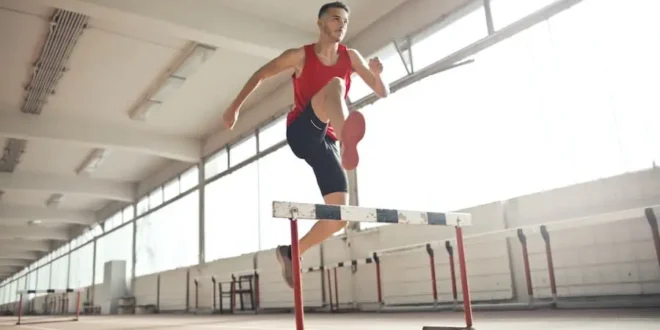Have you ever wondered how high can a human jump? Is it possible for us to reach the heights of some of the world’s highest jumpers?
From the ancient Olympics to modern-day track and field events, jumping has always been a test of strength, agility, and skill. But is there a limit to how high we can go?
Well, the answer might surprise you. While humans may not be able to jump as high as some of the animals, we are still capable of some impressive leaps.
We’ll look at the science behind jumping and closely examine some of the most impressive jumps in human history. Continue reading to the end to get the most out of it. But before that, let’s first answer the question,
How High Can A Human Jump?
We are going to make this section a little bit more interesting. To make it easier to understand, we will look at the current world records of different sports.
And we won’t just focus on the jumping events; we’ll include any sport with interesting jumps made by players.
The high jump world records
In 1993, the Cuban athlete Javier Sotomayor soared 2.45 meters (8 feet ¼ inches) in Spain, setting an unbeatable benchmark in the men’s event.
On the women’s side, Stefka Kostadinova of Bulgaria set the world record in 1987 by clearing a height of 2.09 meters (6 feet 10 ¼ inches) in Rome.
The highest standing jump
In the heart of Texas in 2019, Brett Williams defied gravity and leaped to a record-breaking height of 1.651 meters (5 feet 5 inches) with a vertical jump.
This remarkable feat was three years of intense training and dedication to push his limits higher and higher.
The highest jumpers in basketball
Here is something for basketball fans. Michael Jordan is a name that resonates with every basketball enthusiast. He’s known to have set the bar high with a 1.116m (46 inches) vertical jump.
Though there’s some ambiguity about the current players, some sources claim that the legendary Wilt Chamberlain once soared to an unbelievable 48 inches with his vertical jump.
Highest standing jump on one leg
In 2017 Canadian Evan Ungar made a stunning jump of 1.346 meters despite nursing an injury on his jumping leg.
Even more impressive is that Ungar achieved this record-breaking jump using his other leg.
The highest jump in volleyball
Volleyball is a sport that demands the ability to jump high. Leonel Marshall, a Cuban outside hitter, set the bar high with his 50-inch vertical jump, an impressive 127 cm.
However, the young Canadian player Sharone Vernon-Evans is hot on his heels, having recorded a spike-hit of 383 cm (12 feet 6 1/2 inches) when he was just 18 years old. This makes him the second-highest sports jumper and a rising star to watch out for.
American football jumpers
The record for the highest vertical jump by an NFL player is an impressive 1.116 meters (46 inches), the same height as basketball legend Michael Jordan.
This record was set by Gerald Sensabaugh, a player renowned for his incredible athleticism and raw power.
What Determines How High A Human Can Jump?
So, what factors determine how high a human can jump? Why is it that some people can defy gravity while others can’t? Well, several key factors come into play, and these include:
Muscle strength
One of the most important factors in jumping ability is muscle strength. Specifically, the quadriceps, hamstrings, and calf muscles, muscles play a crucial role in generating the force necessary to jump high.
The quadriceps are located at the front of the thigh and initiate the extension. In comparison, the hamstrings and calf muscles contribute to force production and stabilization during takeoff.
Explosiveness
It refers to an athlete’s ability to generate a large amount of force in a short amount of time.
And this is determined by an individual’s muscle fiber type and neuromuscular coordination.
Fast-twitch muscle fibers, known for their quick contracting ability, play a significant role in explosive power.
Additionally, efficient coordination between the muscles and the nervous system optimizes force production during a jump.
Technique
While raw strength and power are essential, proper jumping techniques can unlock even greater heights and distances.
It involves coordinating various body parts, from your arms to your legs, to optimize energy transfer and maximize jump performance.
To master a proper technique, practice is key. You can efficiently convert raw power into impressive vertical height and distance and achieve the full potential of your jumping ability.
Body composition
Believe it or not, the composition of our bodies, which may include the ratio of muscle mass to body fat, can significantly impact how high we jump.
A higher proportion of lean muscle mass to body fat is advantageous for jumping performance.
Are you wondering how? Let’s break it down for you. Well, muscles generate the force required to propel us off the ground. A higher muscle-to-fat ratio means more functional muscle is available to produce power.
Think of it as a power-to-weight ratio. With less excess body fat to carry around, the muscle’s force becomes more effective in propelling us upward. It’s like shedding unnecessary baggage to soar higher.
Plyometric training
Plyometric training is the secret ingredient to take your leap to new heights. It involves performing exercises that emphasize explosive, rapid movements.
Plyometrics primarily target the muscles and tendons involved in jumping, enhancing their elasticity and power.
It stretches these tissues during the eccentric (lengthening) phase, followed by a quick contraction during the concentric (shortening) phase.
This stretch-shortening cycle enables the muscles to store and release energy more efficiently, resulting in greater force production and improved jump performance. Plyometric exercises also improve neuromuscular coordination and overall athleticism.
Genetics
While some high jumpers are made, some are born. Have you ever been to Kenya? There is a warrior tribe called Maasai where young teenagers reportedly jump to as high as 91 cm during their dancing ceremonies.
Keep in mind that they don’t practice jumping this high, and they do it without struggling. Now imagine how high people from that tribe can jump with proper training.
So yes, our genetic makeup plays a role in determining factors such as muscle fiber composition, muscle architecture, and bone structure, which impact our jumping potential.
Training Exercise That Can Improve Your Vertical Jump
Are you looking to improve your vertical jump? Here is the good news. There are specific training exercises designed to boost your vertical jump.
By targeting key muscle groups and improving explosive power, these exercises can help you unleash your full jumping potential.
And it doesn’t matter whether you are a beginner or a seasoned athlete. It works across the board. Here are a few of the most effective exercises:
Jumping jacks – Jumping jacks are a dynamic full-body exercise that engages multiple muscle groups, including the legs, core, and shoulders. They help improve coordination, explosiveness, and cardiovascular fitness, enhancing vertical jump.
Burpees – Burpees are a challenging exercise that combines a squat, plank, and explosive jump. They target the entire body, building strength, power, and endurance. Incorporating burpees into your training routine allows you to develop the explosive force needed for higher vertical jumps.
Jumping squats – This plyometric exercise combines a squat and a jump, focusing on explosive power. Start in a squat position and explode upward, propelling yourself into the air. Land softly and immediately repeat the movement.
Mountain climbers – Mountain climbers target the core, shoulders, and legs. This exercise mimics the explosive movements required in jumping, improving muscular strength and coordination that directly transfers to your vertical jump.
Jump ropes – Jumping rope is a simple yet effective exercise for improving cardiovascular endurance, leg strength, and foot speed. It also helps to develop coordination and timing, vital for executing powerful and precise jumps.
The Biomechanics Of Jumping
When you jump, you first bend your knees and hips to load the muscles in your legs and core. As you do so, potential energy builds up in your muscles, like a coiled spring waiting to be released.
This creates potential energy in the muscles. As you extend your legs and hips, you convert that potential energy into kinetic energy, which propels us off the ground.
To generate maximum force, you must use the proper jumping technique, which may involve using the arms to generate momentum, bending the knees and hips to load the muscles, and extending the legs and hips to generate force.
Conclusion
How high can a human jump has been a hot topic, but this article has answered comprehensively.
While the average person can only jump a few feet off the ground, some athletes are known to push the limits of what a human body can do in terms of jumping.
Don’t be discouraged by the world records that seem unbreakable. You can also do it with proper training and exercise.
 Being Human
Being Human




